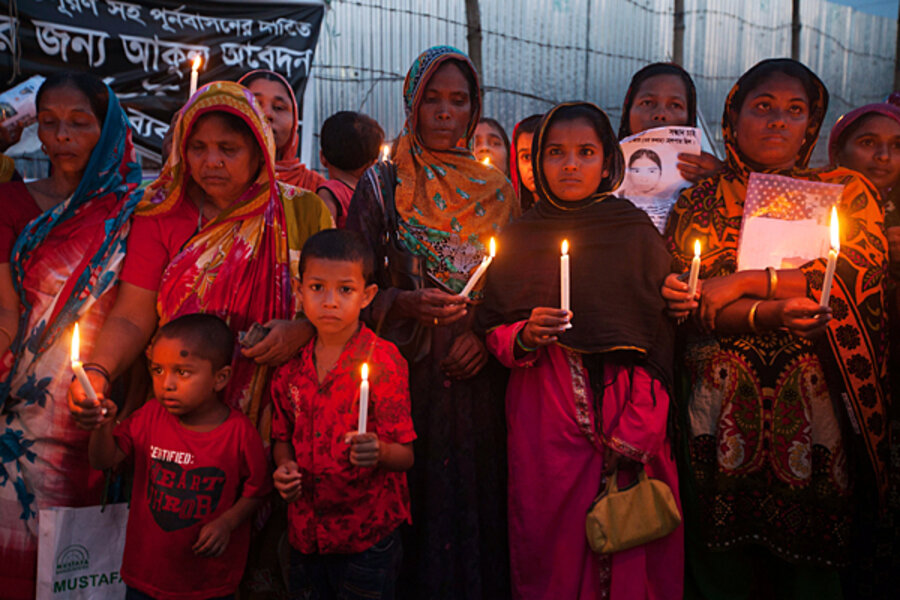After Rana Plaza, efforts on Bangladesh worker safety
Loading...
| Dhaka, Bangladesh
In the six months since the factory collapse at Rana Plaza killed over 1,100 workers and injured 2,000 others, international brands and organizations have formed three different groups to improve working conditions inside Bangladeshi factories.
The International Labor Organization (ILO) this week announced an initiative to improve the South Asian nation's garment factories. The new effort joins two other safety programs, the “Alliance for Bangladesh Worker Safety” made up of 20 North American retailers including Walmart and Gap, and the “Accord on Fire and Building Safety” signed by more than 100 apparel corporations, including PVH, Primark, H&M, and Loblaw.
The three initiatives indicate a deepening interest from the global community in worker safety in Bangladesh. Yet some are concerned that a lack of coordination among the groups will lead to haphazard implementation.
“We need to make sure we are [following] the same standards,” says Gilbert Fossoun Houngbo, the deputy director general of the ILO, the UN's leading advocate for safer working conditions. “Otherwise you are going to get different results. It does not make sense.”
The ILO initiative, co-sponsored by the Bangladesh government, will conduct a fire and building safety assessment on 1,000 to 1,500 factories and run safety and health awareness training. The $24.1 million project – funded mainly by the British and Dutch governments – will also provide skills training to survivors of Rana Plaza and the 2012 Tazreen factory fire. The project will continue for three-and-a-half years.
A key difference between the initiatives is the level of legal responsibility they demand from factory owners. The Accord, started in May, is a legally binding agreement between retailers, labor organizations, and non-government organizations to improve working standards. The Alliance, formed in July, lacks a legally binding commitment.
In addition to differing legal standards, in some cases it is unclear which factories are covered by which program. For instance, half of the factories listed by the Alliance also manufacture clothes for Accord members, according to local media reports.
Although an agreement on common standards between the three groups has not been reached, stakeholders are planning to meet in November to work on a checklist for assessment, says Reaz Bin Mahmood, vice president of Bangladesh Garment Manufacturers and Exporters Association.
Not all factories are equal
A fire at a dyeing factory earlier this month in Gazipur further revealed that not all kinds of factories are covered under the factory safety initiatives being adopted by the international brands. The Aswad Composite Mills Limited, which caught fire on Oct. 8, was not within the lists prepared by the international brands.
Knitting and dyeing factories are either hired directly by Western and European retailers or via garment suppliers. They are not listed in the new safety deals as they do not produce clothes, Mr. Mahmood told the Monitor.
Minimum wages
After workplace safety the most pressing issue for the 4 million workers in Bangladesh's $21.5 billion garment industry – 80 percent of whom are women – is wages. The government is likely to announce a new minimum wage for garment workers later this month. The minimum was last increased in 2010 and garment workers have engaged in clashes with police and authorities in recent months demanding pay hikes.
Bangladeshi garment workers are entitled to a monthly minimum wage of $38, “which is even lower than Vietnam and Cambodia,” says Mushrefa Mishu, president of the Garment Workers’ Unity Forum, a labor rights organization. Workers in Vietnam and Cambodia earn a minimum wage of $80.
Garment workers have demanded a monthly minimum wage of $102 but are apprehensive that the minimum wage will be increased to just $64 [5000 taka] in the face of reluctance from factory owners.
“If 5000 taka [$64] is fixed as the minimum wage the government will have to control the cost of healthcare and house rents and ensure rationing system. Unless the cost is controlled, it will be of no use increasing the wages,” says Nazma Akhter, president of Sammilita Garment Sramik Federation, another labor body.
“We have sought the minimum wage of 8000 taka after consulting with nutritionists. The minimum wage is related to a lot of factors including a worker’s physical strength which impacts on productivity,” says Ms. Mishu.
She warns that any amount below $102 will lead to further demonstration and protest. The wage commission is composed of representatives from the government, garment owners and labor bodies. It is tasked with revising wages in proportion to the rise in the cost of living, including the cost of commodities, gas, electricity and water.






